Exploring the Hidden Optimization Potential of C
 Sathya
SathyaWhy C Language is Essential for Modern Programming and Operating Systems
The C programming language, created by Dennis Ritchie at Bell Labs in 1972, is often considered an old programming language. However, this language should not be underestimated or learned merely for the sake of familiarity. In fact, C is far from obsolete it’s the foundation of much of modern computing. Without it, we wouldn't have many of the software applications and underlying technologies that power today’s devices.
C has played a pivotal role in the creation of many operating systems and software applications. Its ability to provide low-level access to memory and system resources makes it incredibly powerful for performance optimization and code efficiency. Popular operating systems, like Linux and UNIX, were built using C, and this language remains integral to system-level programming today.
If you’re interested in creating your own operating system or working on performance-critical software, learning C is a must. The internals of C help you understand how hardware and software interact, and without this knowledge, creating an OS or similar products becomes extremely challenging.
In this blog, we’ll explore why C continues to be an indispensable tool for developers and why mastering it is a critical step toward understanding the core workings of modern technology.
Although we may not see C as frequently in the front-end development of products, all the core technologies behind these products rely on C. It is the backbone of high-performance, efficient systems that drive many of the essential tools and applications in use today.
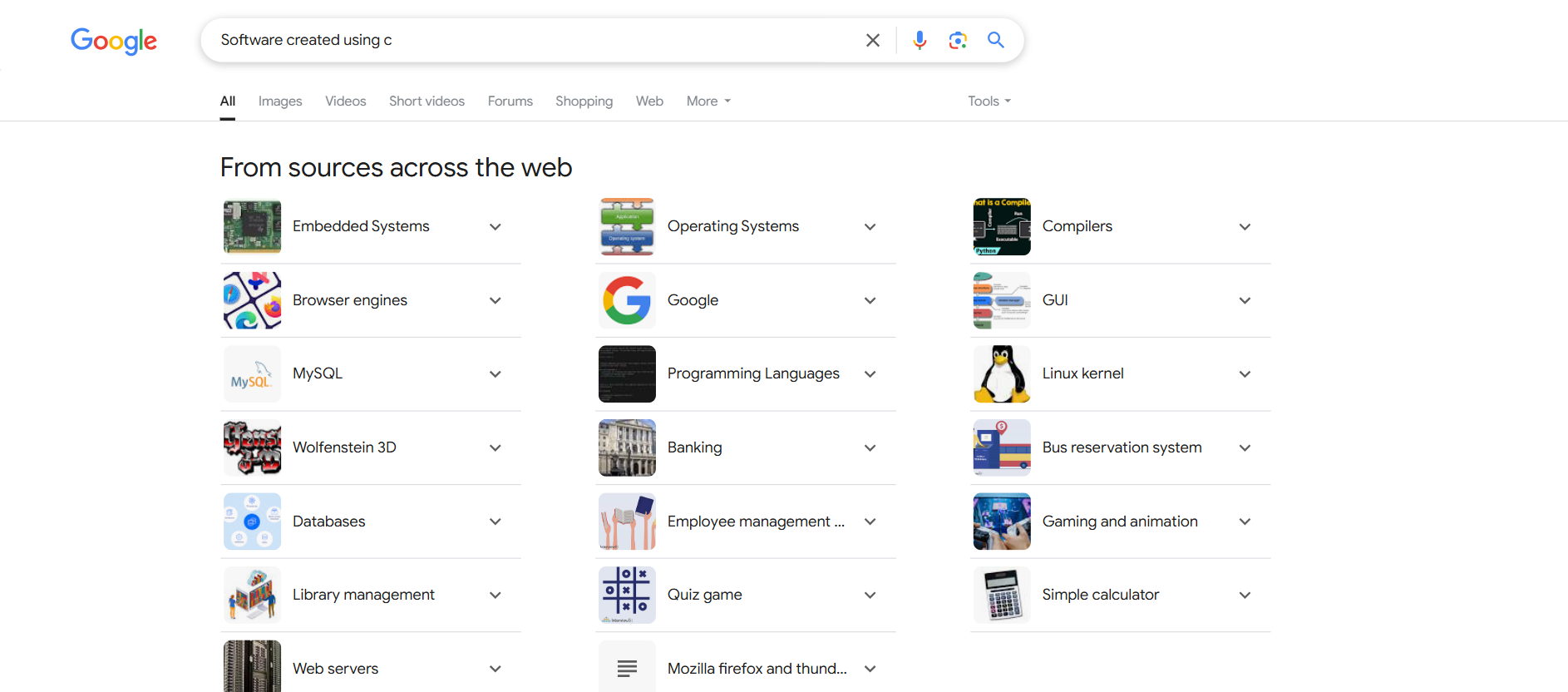
Web browsers like Chrome and Firefox, along with many web applications, are also developed using the C programming language. Industries such as Industry 4.0, 5.0, IoT, embedded systems, and the gaming industry (including Adobe games) rely heavily on C. Without C, it would be impossible for these industries to run optimized applications and generate profits.
Do you Know ?
The C programming language is often called the mother of all languages because it's the foundation for many modern programming languages, including C++, Java, and C#, and is used to create operating systems and other critical software infrastructure.
C and C++ languages are both powerful and widely used, but while they share many similarities, C++ offers additional features, such as object-oriented programming (OOP) and enhanced abstraction capabilities. However, both languages play a significant role in software development and serve different purposes. C is often used for low-level system programming, whereas C++ builds on that foundation with more advanced features suited for larger and more complex software projects.
For roles such as Network Engineers, Cloud Engineers, Linux Administrators, and System Security Experts, a deep understanding of C is essential. Without knowledge of how systems interact at a low level, such as through memory management, pointers, and system calls concepts central to C it's difficult to advance in these fields. As technology continues to evolve, a strong grasp of C will provide the foundational knowledge needed to understand and manage modern operating systems, networks, security systems, and cloud infrastructure.
In the future, without this fundamental understanding, professionals may find themselves limited in their careers, unable to keep up with the growing demands and complexities of modern systems and technologies. C is not just a stepping stone but an ongoing necessity for anyone pursuing a technical career in these areas.
Performance Tuning and the Importance of C/C++ Knowledge in Career Growth
Performance tuning plays a crucial role in modern engineering, especially in the corporate world. Enhancing the performance of existing systems can lead to significant benefits. Even a 1% improvement in system performance can result in substantial profits for a company. Without a deep understanding of C and C++, optimizing a system built using these languages becomes a challenge. Engineers who don’t understand the internals of these languages might find themselves stuck in their career growth, as performance is critical in any industry.
In fields like the gaming industry, performance optimization is paramount. For instance, user experience (UX) and performance are critical factors in determining the success of a game. A laggy or poorly performing game can negatively impact user retention and ratings.
One excellent example of the use of C and C++ for performance tuning is in the space industry, with organizations like NASA and SpaceX. Both use C and C++ extensively to ensure the performance and fine-tuning of their systems. NASA, for example, relies on these languages for controlling the systems onboard spacecraft. These systems must operate flawlessly in extremely challenging environments like space, where every millisecond and byte of performance matters.
Take NASA’s Mars satellite mission, for example. The entire system, including the control engine, relies on efficient programming languages like C and C++. If humans attempted to communicate with the device directly, it wouldn’t understand our language. This is where programming languages come into play, as they enable us to communicate with machines.
While there are several programming languages, like Java and Python, that can be used for communication, C stands out due to its low-level control over hardware and memory. In our previous blog, we explored how to read the entire RAM of a system. This is made possible by the power and flexibility of C, which gives developers the ability to interact directly with system memory, something that higher-level languages struggle with.
What is the Final Goal in Programming Languages?
When choosing a programming language, it's important to define your goal:
If the goal is faster execution and optimization, then C is your best bet. Its low-level capabilities provide direct control over memory and hardware, making it ideal for performance-critical applications.
If the goal is faster development, then higher-level languages like Python, Java, or others may be more suitable. These languages come with rich libraries, built-in functionalities, and ease of use, which help developers build applications more quickly but at the cost of execution speed.
If the goal is safety-critical systems and reliability, then Ada programming language may be more suitable. Ada is specifically designed for high-integrity and real-time systems, offering strong typing, concurrency support, and built-in features for error checking, making it ideal for applications in aerospace, defense, and other safety-critical domains, although it may be less flexible than more general-purpose languages.
Curiosity Rover and the Power of C Language
Take the example of the Curiosity Rover a spacecraft that has been exploring Mars since 2012. For its movement and control systems, it is staggered with over 2.5 million lines of C code. This vast amount of code ensures that the rover operates efficiently and effectively on Mars, where resources and time are incredibly limited. Despite the complex environment and the vast distance from Earth, the rover continues to perform its tasks, thanks to the optimization provided by C.
Similarly, mobile devices also rely on the same principles. While we may sometimes experience minor glitches (like in picture clicking), the core functionality is optimized using lower-level programming languages like C for better performance. The Curiosity Rover is able to function seamlessly because of how C handles memory, performance, and resource management in a way higher-level languages cannot.
SpaceX Rocket Software and the Power of C++
Take the example of SpaceX, one of the most innovative companies in space exploration. Their rockets and space-based vessels rely on highly optimized software for their successful launches and operations. A significant portion of this software, especially the core control systems, is written in C++ a language that offers high performance and efficiency, which is crucial for handling the complex and time-sensitive operations of space missions.
For the Falcon 9 rocket, the software is responsible for interpreting real-time data, controlling the rocket’s movement, and ensuring safety during launch and flight. The software is designed to manage inputs such as sensor readings, GPS data, and inertial measurements, which must be processed with precision and speed. C++ is the perfect choice for these tasks because it allows SpaceX engineers to optimize performance and control system memory usage, ensuring smooth and efficient operation.
Much like the Curiosity Rover, which operates in the harsh conditions of Mars and relies heavily on C for its low-level control and optimization, SpaceX’s rockets also benefit from the efficiency and power provided by C++. With complex systems that must function flawlessly, SpaceX uses C++ for high-performance computation, ensuring that the vehicle's navigation, guidance, and control systems run in real-time with minimal delays. This allows SpaceX to execute intricate maneuvers such as rocket landings and orbital adjustments with precision.
Additionally, engineers at SpaceX create domain-specific languages to allow non-software experts to configure the systems easily. Despite this abstraction, the underlying power of C++ continues to ensure that the rocket's mission-critical software operates at peak efficiency.
Why did this company use C/C++ instead of other languages available in the market?
Because C is highly efficient and offers low-level control, it allowed the engineering team to fine-tune every aspect of the rover's behavior. It provides control over every part of the machine. In contrast to other programming languages like Python or Java, where we cannot control the system as precisely as needed, we have to use them as they are provided. If our goal is learning or developing applications, we can use languages like Python, Perl, Java, and other similar tools.
However, if our requirements include:
→ Fine-tuning
→ Optimization
→ Rapid development
We need low-level control. For this reason, we use C language. C has the capability to meet these needs. This is one of the main reasons why embedded devices, microcontrollers, IoT devices, satellites, and any kind of core software company use C as their programming language.
If you apply for software developer jobs, especially at core product-based companies, they may ask questions related to C++ or C and ask you to implement code. Some companies may advise against using certain features in C++. Why is that? Let’s discuss it in a later blog.
Logic-wise, all programming languages are similar, but the way we create algorithms to solve problems can differ. However, when it comes to performance and comparing one programming language to another, C stands out from the crowd. Its low-level nature and direct control over hardware make it the preferred choice for performance-critical applications.
Let us consider an example to see why a C program stands out from other programming languages like Python.
Problem : Sum of n natural numbers.
Sum = 1+2+3+4+5+…+n
Solution: To solve this problem, we need to write a step-by-step set of instructions. This is technically called an algorithm.
After designing the algorithm, if our final goal is to code quickly, we may choose Python. However, if we need optimized code and better performance, languages like C are preferred.
As discussed earlier, the main focus of the industry is making a profit. one way through sales and another through optimizing the performance of existing systems. From an industry perspective, optimization and performance are not just terms; they represent significant profit opportunities for the business.
→ To compare the performance of calculating the sum of n natural numbers (where n could be a million) between Python and C, we can analyze the execution time for both languages. Here's how the two approaches might look in Python and C.
Install the GCC compiler and Python interpreter on your system to follow this demonstration.
For Python, you can install Anaconda, which helps manage all necessary libraries and packages in one place. For C/C++, you need to install a GCC compiler. There are various C compilers available, and one of them is MinGW (Minimalist GNU for Windows). MinGW is an open-source development environment that provides a Windows port of the GNU Compiler Collection (GCC). It allows you to compile and run C, C++, and Fortran programs on Windows without requiring a full Unix-like environment.
To install GCC on Windows, follow this document: GCC Installation Guide
s = 0
for i in range(100000000):
s = s + i
print(s)

Here, time is a function used to check how much CPU time is taken by the program. In this case, using Python, it took approximately 9.935 seconds.
Time command measures the execution time of a command.
#include <stdio.h>
void main() {
int s = 0;
int i;
for (i = 0; i < 100000000; i++)
{
s = s + i;
}
printf(" Sum of natural numbers : %d", s);
}
If we execute this code, an executable file called a.exe is created by default. However, we can also specify a custom output file name using a specific command.
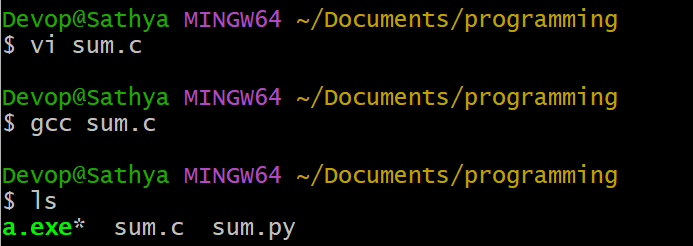
In C, after compiling your program, you execute it using ./a.exe

In Python, the code executes without errors because Python's integer type (int) supports arbitrary precision, allowing it to handle extremely large numbers without overflow. However, in C, the output may differ due to its use of fixed-size integer data types, each with specific size limitations. Standard int types have a maximum range based on system architecture, and exceeding this limit results in integer overflow. To accommodate larger values, C provides long int, and for even greater capacity, long long int. This precise control over data types and memory usage is a key feature of C and similar low-level languages, making them well-suited for performance-critical applications.
To get the exact output If the sum fits within long long int, then yes, the output will match Python.
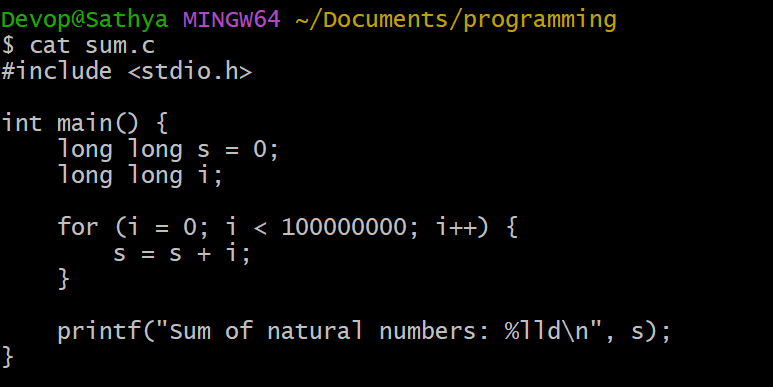
Lets discuss this in later days !!
Output form C program

Output from Python program

Let's measure the time taken for both approaches using the time function.
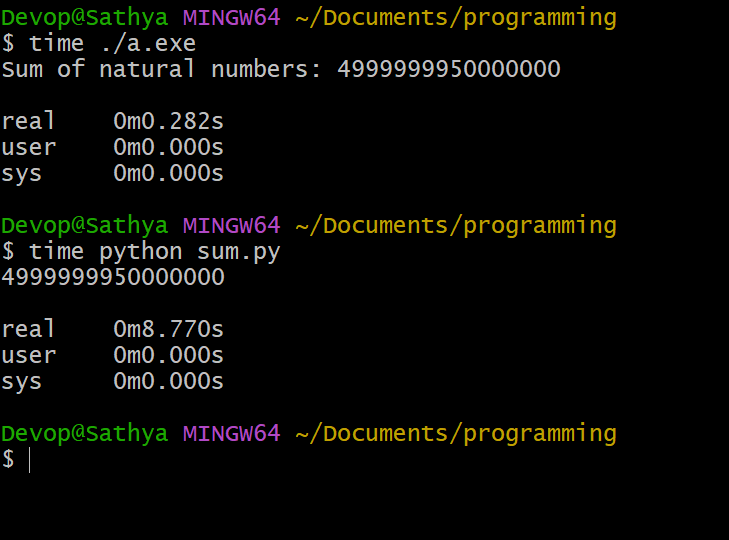
You can see a huge difference: Python took 8.770 seconds, whereas C took less than a second (i.e., 0.282 seconds). This code is not even optimized, yet it runs significantly faster. If we apply further optimization using additional compiler commands, the execution time will decrease even further almost like magic!
gcc -O3 sum.c -o sum.exe
// here -O3 is the highest level of optimization, making the program run significantly faster.
// -o sum.exe → Specifies the output file name needed
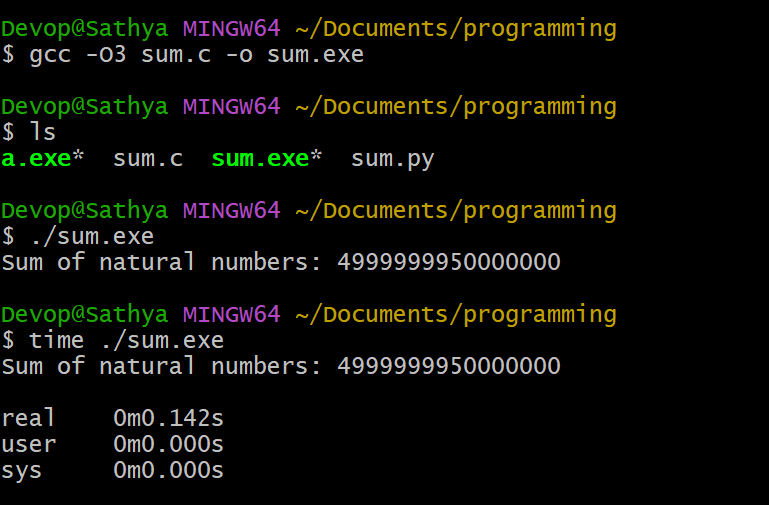
Reason for this C is compiled into machine code before execution, making it much faster. Python is interpreted, processing code line by line, which adds overhead.
In today's agile and fast-moving world, everything is accelerating. No one wants a slow and laggy computer, which is why optimization is the key.
In the example above, we saw the sum of n natural numbers. Let's say n is a million. The output remains the same in C, Python, and Java. However, from an industry perspective, companies deal with far more complex problems that require vast amounts of data and computational power.
Even though Python is simple and easy to use, it takes more time compared to lower-level languages like C and C++.
The key factor here is "saving time."
That’s why search engines like Google use C/C++ (or similar languages) to build their core systems, reducing execution time and improving efficiency!
Ever wonder why RAM and CPU are costly devices?
One of the reasons for the high cost of RAM and CPUs is the global silicon shortage. Silicon is a fundamental material used in semiconductor manufacturing, and disruptions in its supply chain have contributed to increased production costs and limited availability of electronic components.

When a user interacts with an application, such as Netflix, the request is processed by a computer system. To function properly, a computer requires an operating system (OS), which, in turn, relies on critical hardware components like the CPU (Central Processing Unit) and RAM (Random Access Memory).
CPU (Central Processing Unit): Acts as the brain of the computer, executing instructions and performing computations.
RAM (Random Access Memory): Provides temporary storage for active processes, allowing the CPU to access data quickly for efficient execution.
Both RAM and CPUs are built using millions (or even billions) of transistors tiny electronic switches that control the flow of electrical signals. These transistors operate in a binary system, where:
High voltage represents "1" (ON)
Low voltage represents "0" (OFF)
Transistors understand only 1s and 0s, which form the basis of binary language—the fundamental language of a CPU. The same technology that powers processors is built using transistors, which are electronic devices made from silicon.
In recent times, there has been a shortage of silicon, as seen in various reports and case studies. This shortage has led to a rise in silicon prices, which, in turn, has increased the cost of electronic devices such as laptops, mobile phones, computers, and servers. Since transistors are essential components of CPUs and RAM, their high demand and limited supply directly impact the pricing of these devices.
For an individual consumer, this increase in cost might not be significant. However, for large-scale technology companies like Netflix, the impact is much greater. Consider a scenario like a live-streamed cricket match on JioCinema (Hotstar) the company must deploy a massive number of computing resources to handle millions of simultaneous viewers.
For example:
Load balancing requires launching multiple instances.
Millions of servers/computers are deployed, consuming vast amounts of CPU and RAM.
Over 10,000 server instances may be running simultaneously to handle peak demand.
Since the cost of RAM and CPUs has increased due to the silicon shortage, companies must either:
Maintain high costs, which makes services more expensive for users.
Optimize existing infrastructure, which can be a complex process but helps reduce costs.
This silicon transistor correlation is one of the factors driving higher prices for cloud based services, but there are multiple other contributing factors as well.
How will Giant companies like Hotstar, Netflix able to tackle this challenge ?
Netflix, like other tech giants, focuses on marginal profit while managing high hardware infrastructure costs, which can significantly impact profitability. To address this, they take a strategic approach:
Analyze requirements – Identify key factors affecting infrastructure costs.
Optimize compute usage – For example, reducing the number of compute instances from 100,000 to 90,000 results in a 10% cost savings, directly leading to increased profit.
However, businesses don’t just focus on profits , they also prioritize customer satisfaction. Simply cutting infrastructure costs without careful planning could cause buffering issues, performance degradation, or system errors, negatively impacting the user experience.
Optimization Strategies
To maintain service quality while reducing costs, companies focus on system optimization rather than just hardware reduction.
One approach is to rewrite application code for better efficiency.
Initially, an app might be written in Java or Python, but switching to C or C++ can significantly improve performance.
For instance:
A task that takes 30 minutes in Python could be executed in 15 minutes in C.
This reduces CPU and RAM usage, leading to substantial cost savings.
By optimizing software, companies achieve a balance between profit growth and an excellent user experience ensuring cost efficiency without compromising performance.
Conclusion
The C programming language remains an essential pillar of modern computing, playing a crucial role in operating systems, embedded systems, gaming, and performance-critical applications. Despite the rise of high-level languages like Python and Java, C's ability to provide low-level hardware control and unmatched performance optimization ensures its relevance even today.
In our next article, we will dive deeper into why C executes faster, how its internal mechanisms work, and what makes it more efficient compared to high-level languages. Stay connected for more insights on performance optimization and system-level programming! 🚀
References :
Subscribe to my newsletter
Read articles from Sathya directly inside your inbox. Subscribe to the newsletter, and don't miss out.
Written by
